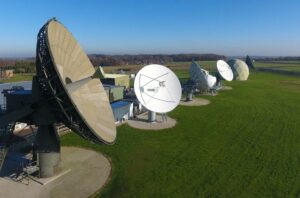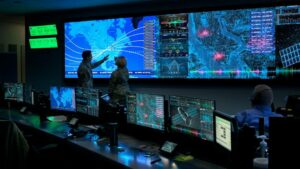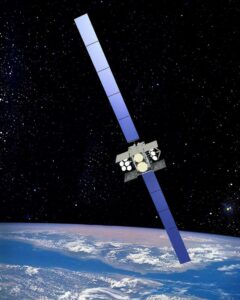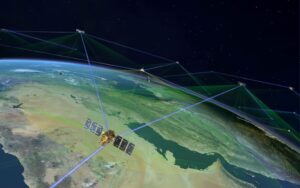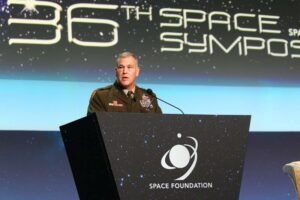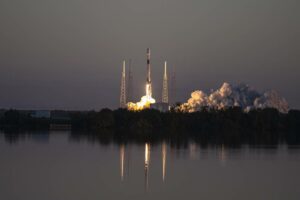
WASHINGTON — Gen. David Thompson spent his last moments in uniform much like he’s spent the last four years: explaining what the U.S. Space Force does.
After leaving the Pentagon for the last time on Dec. 14, the now-retired vice chief of space operations, set off to Indiana to give the winter commencement address at Purdue University, his alma mater. Before offering the standard well wishes and career advice, Thompson gave what has essentially become a stump speech for Space Force officials addressing the general public.
“I know there’s a question that’s running through some of your minds here today, and that question goes something like this: ‘The Space Force? Is that really a thing? I thought it was just a Netflix series,’” he said in the Dec. 17 speech.
He went on to explain that the service operates the GPS satellites that underpin the mapping applications and cell phone networks and banking systems they rely on daily. He then talked about how the Space Force’s communications and weather satellites and its role in tracking objects that orbit the Earth to warn of possible collisions.
For much of Thompson’s 38-year career, these missions have been at the core of U.S. military operations in space. But as threats increase in orbit and on Earth and as commercial innovation introduces new capabilities and ways of operating, he said the Space Force’s role will grow in the coming years.
Thompson recently sat down with C4ISRNET to talk about how the Space Force is laying a foundation for that growth and what resources are needed to support it. This interview has been edited for length and clarity.
When you think back to the early days of the Space Force, what were some of the most difficult aspects of standing up a new service and what went more smoothly than you expected?
Let me say first and foremost, Air Force Space Command was already doing a lot of operational missions every single day. So, the first thing we did was try to figure out how to keep the missions going, keep the programs going, keep those processes going, make sure that none of those missions or activities failed.
We had created this wonderful plan, it was a tremendous plan, for how to establish this Space Force. And in essence, the plan said, after the law is signed, give us a year to plan and prepare to establish the U.S. Space Force and on day one of year two — the anniversary of the year after the law is signed — we will establish a Space Force. Well, the law said, ‘No, you’re a Space Force on day one.’
The second thing that the law said was, you will be established in 18 months. Now, that’s all the law said, so we got to define the rest of what that meant. But what we said was, OK, we need an approved organizational structure for the entire Space Force in that 18 month period. And it has to be resourced — resourced meaning all of the people and support and other things need to be part of the plan. So that was probably the first big thing that we did was make that happen.
I think the second big accomplishment was, we gained tremendous momentum in changing our architectural approach to space systems, which was moving away from a relatively small number of very capable and very expensive satellites to proliferated constellations where you have tens, hundreds, perhaps one day thousands of satellites, each one of which is much cheaper and much less capable, but in aggregate, the constellation is as capable, maybe even more capable. And it’s very resilient, because it’s hard to degrade under attack.
So when you think about the design work we’ve done, we’re already in the middle of that for missile warning and missile tracking. We’ve created the design for space data networks that is underway now. And we’re looking at other ways of doing it as well. I think that would have been done under Air Force Space Command, but I don’t think it would have gone as quickly if there hadn’t been a Space Force and a service chief there saying we have to move in this direction.
And then the third is bringing in organizations and people from other services. Now, that certainly wasn’t without lumps and bumps. We have a process for inter-service transfers, as it’s called inside of the Department of Defense. But really, it’s designed for one or two people here, a couple of people there. For a while we were doing 700 people a year. And so we had to figure out how to do that. Like I said, it wasn’t without bumps along the way. But I think another success is how we were able to create this large-scale process to bring in large numbers of people from those other services.
There was a big push from Congress at the time the Space Force was created to improve the space acquisition system. What progress has the service made in this area?
We moved out remarkably in certain areas and not enough in others. On the one hand, folks will criticize us for not moving quickly enough and on the other hand, the laws and the policies and regulations that we don’t control didn’t let us move. We bear some responsibility for that, but I would say, I think you’re seeing some incredible work right now.
You’re probably following some of the work of the Space Development Agency and how fast they’re turning. They have more work to do to demonstrate that they will continue to do it and repeat doing it. I would say, so far, they are demonstrating that very clearly. But they have to continue to build a track record of success.
The Space Rapid Capabilities Office down in Albuquerque is similar. When you look at how quickly they moved out, the things they’re delivering, they’re doing a wonderful job. And then Space Systems Command has also worked towards accelerating their processes. And I think they had the furthest to go because they’ve been doing this for many years and many of those processes that are specifically dictated by law and policy that slow us down are the programs that they end up doing. But they’re working hard to accelerate as well.
In what ways has the commercial sector helped to drive change in how the service thinks about buying new satellites and other space capabilities?
For many years — especially in national security space — we built satellites the way auto manufacturers built custom coaches 100 years ago. They’re exquisite, they’re beautiful, they’re expensive, they’re tremendously capable, but you build them one at a time. A lot of these companies now have created production lines for satellites that they’re building in the hundreds and thousands.
This has done three things. It’s demonstrated how to build satellites on a no-kidding production line. The second thing is it’s driving the cost of technology down. And then it’s driving speed.
The Space Force’s budget has more than doubled since it was created. Do you expect funding to continue to grow?
The space budget needs to grow because there are still more missions that are migrating to space. Connectivity through space is going way beyond traditional satellite communications and we’ve got to put that in place. We were already talking publicly about the need for tracking and targeting systems, surface moving target indication, and air moving target indication is coming next. Some of those missions that have been done in a benign environment or in environments where we have air superiority, they have to move to space. And so work to do to help protect our use of space and deny it to an adversary.
All of that is mission growth. So the budget has to grow. The challenge is in this environment, defense budgets are likely not to grow significantly in the near future the way they have in the recent past. And so exactly how much growth we will see will be a factor of what the nation can and will spend on defense and how much of that we’re prepared to allocate to the Space Force.
As the service looks to grow and modernize its current architecture, officials have said they want to pivot to more resilient systems by 2027. What progress is the Space Force making?
I would say [2027] is probably an inflection point. In some areas, we’ll be a long way toward that pivot. In some, we’ll be firmly midstream and others we’ll just be starting. Some of that is a function of just laying in the resources and the work to be done.
We won’t be all the way done, but a missile warning, missile tracking architecture that is global, that can track emerging threats like hyperglide vehicles and maneuvering upper stages and other things — it’s going to be very close to done in that timeframe. Our space data network, which is going to include some Space Development Agency, some commercial capabilities, and some of our own — that’s what I would say would be midstream by then, meaning a lot of a lot of capability there, a lot of connectivity there, but not yet the full connectivity and capacity that we need. Other missions, like ground moving target indication, we should be in pretty good shape and well underway, but it’ll still be a nascent capability.
There’s a long way to go. Plenty of opportunities to continue to do well or plenty of opportunities to have challenges. But the early indicators in terms of the way we’ve designed these systems — both in terms of costs and performance, especially performance under attack — the early deliveries and early aspects of the acquisition programs are bearing fruit.
Courtney Albon is C4ISRNET’s space and emerging technology reporter. She has covered the U.S. military since 2012, with a focus on the Air Force and Space Force. She has reported on some of the Defense Department’s most significant acquisition, budget and policy challenges.
- SEO Powered Content & PR Distribution. Get Amplified Today.
- PlatoData.Network Vertical Generative Ai. Empower Yourself. Access Here.
- PlatoAiStream. Web3 Intelligence. Knowledge Amplified. Access Here.
- PlatoESG. Carbon, CleanTech, Energy, Environment, Solar, Waste Management. Access Here.
- PlatoHealth. Biotech and Clinical Trials Intelligence. Access Here.
- Source: https://www.defensenews.com/battlefield-tech/space/2023/12/20/thompson-touts-space-force-acquisition-achievements-in-exit-interview/
- :has
- :is
- :not
- :where
- $UP
- 10
- 100
- 14
- 17
- 2012
- 70
- 700
- a
- Able
- About
- accelerate
- accelerating
- achievements
- acquisition
- activities
- address
- addressing
- advice
- After
- agency
- aggregate
- ago
- AIR
- Air Force
- All
- allocate
- ALMA
- along
- already
- also
- an
- and
- Anniversary
- Another
- applications
- approach
- approved
- architectural
- architecture
- ARE
- AREA
- areas
- AS
- aspects
- At
- attack
- auto
- away
- back
- Banking
- Banking systems
- BE
- Bear
- beautiful
- because
- become
- been
- before
- Beyond
- Big
- both
- bring
- Bringing
- budget
- Budgets
- build
- Building
- built
- but
- Buying
- by
- called
- CAN
- capabilities
- capability
- capable
- Capacity
- Career
- cell
- certain
- certainly
- challenge
- challenges
- change
- changing
- cheaper
- chief
- clarity
- clearly
- Close
- coming
- commencement
- commercial
- Communications
- Companies
- Congress
- Connectivity
- continue
- control
- Core
- Cost
- Costs
- Couple
- covered
- create
- created
- Current
- custom
- daily
- data
- David
- day
- Days
- dec
- Defense
- define
- Deliveries
- delivering
- demonstrate
- demonstrated
- demonstrating
- Department
- department of defense
- Design
- designed
- Development
- dictated
- DID
- difficult
- direction
- do
- does
- doing
- done
- Dont
- doubled
- down
- drive
- driving
- each
- Early
- earth
- emerging
- Emerging Technology
- end
- enough
- Entire
- Environment
- environments
- especially
- essence
- essentially
- establish
- established
- Even
- Every
- exactly
- Exit
- expect
- expected
- expensive
- Explain
- explaining
- exquisite
- factor
- Failed
- far
- FAST
- Figure
- firmly
- First
- Focus
- following
- For
- Force
- foremost
- Foundation
- four
- from
- full
- function
- funding
- future
- gained
- gave
- Gen
- General
- general public
- Give
- Global
- Go
- Goes
- going
- gone
- good
- got
- gps
- Ground
- Grow
- Growth
- had
- hand
- happen
- Hard
- Have
- he
- help
- helped
- here
- his
- How
- How To
- HTTPS
- Hundreds
- i
- if
- images
- improve
- in
- include
- Increase
- incredible
- Indiana
- indication
- Indicators
- Inflection
- Inflection Point
- Innovation
- inside
- Interview
- Introduces
- IT
- ITS
- Job
- jpg
- just
- Keep
- Know
- large
- large-scale
- Last
- Law
- Laws
- laying
- leaving
- Length
- less
- let
- like
- likely
- Line
- lines
- Long
- Look
- looking
- LOOKS
- Lot
- made
- make
- Making
- Manufacturers
- many
- mapping
- maybe
- me
- meaning
- meant
- Middle
- migrating
- Military
- minds
- Mission
- missions
- modernize
- Moments
- Momentum
- Month
- months
- more
- most
- move
- moved
- moving
- much
- nascent
- nation
- National
- national security
- Near
- Need
- needed
- needs
- Netflix
- network
- networks
- New
- next
- None
- now
- number
- numbers
- objects
- of
- off
- offering
- Office
- officials
- on
- ONE
- operates
- operating
- operational
- Operations
- opportunities
- or
- Orbit
- organizational
- organizations
- Other
- Others
- our
- out
- own
- part
- past
- pentagon
- People
- performance
- perhaps
- period
- phone
- Pivot
- Place
- plan
- plato
- Plato Data Intelligence
- PlatoData
- Plenty
- Point
- policies
- policy
- possible
- Prepare
- prepared
- pretty
- probably
- process
- processes
- Production
- Programs
- Progress
- protect
- public
- publicly
- Push
- put
- question
- quickly
- rapid
- really
- recent
- recently
- record
- regulations
- relatively
- rely
- repeat
- Reported
- reporter
- resilient
- Resources
- responsibility
- REST
- right
- Role
- running
- s
- Said
- satellite
- satellites
- say
- saying
- Second
- sector
- security
- see
- seeing
- Series
- service
- Services
- set
- Shape
- she
- should
- signed
- significant
- significantly
- similar
- since
- single
- slow
- small
- smoothly
- So
- so Far
- some
- something
- Space
- Space Force
- specifically
- speech
- speed
- spend
- spent
- stages
- standard
- standing
- Starting
- Still
- structure
- success
- support
- sure
- Surface
- system
- Systems
- Talk
- talking
- Target
- targeting
- Technology
- tens
- terms
- than
- that
- The
- the Law
- their
- Them
- then
- There.
- These
- they
- thing
- things
- think
- Thinks
- Third
- this
- thompson
- those
- thought
- thousands
- threats
- three
- Through
- time
- timeframe
- to
- today
- toward
- towards
- track
- Tracking
- traditional
- transfers
- tremendous
- tremendously
- try
- Turning
- two
- u.s.
- U.S. Space Force
- under
- underpin
- Underway
- university
- us
- use
- Vehicles
- very
- vice
- want
- warning
- was
- Way..
- ways
- we
- Weather
- WELL
- went
- were
- What
- when
- which
- while
- will
- Winter
- wishes
- with
- without
- wonderful
- Work
- worked
- working
- would
- year
- years
- yet
- you
- Your
- zephyrnet

